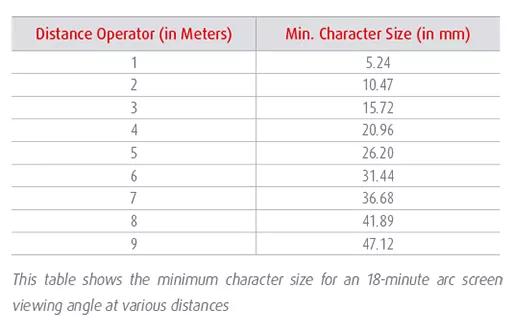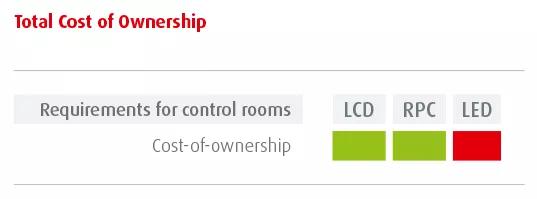Précédent
13 janv. 2017
Top 5 questions to ask when selecting a video wall
EXAMEN FUTUR 6 min de lecture
Millions of square feet of video walls are being installed annually − and the market is enjoying double-digit growth. There are more options than ever when it comes to building large video walls for 24/7 control rooms. While some video walls must “wow” prospective viewers visually to catch their attention (i.e., advertising and digital signage), others focus on ergonomic design, functionality, serviceability, and critical data within a continually manned 24/7 decision-making environment (i.e., control room).
The contenders – LCD, RPC and LED
Only Tiled LCD, RPC (Rear Projection Cube) and LED (Direct View LED) are considered to be viable technologies for control rooms in critical infrastructure environments. These include utilities, traffic/transportation agencies, and security and surveillance centers, where having accurate, real-time data can mean the difference between life and death. Each video wall technology has its own strengths and weaknesses, so how do you determine which one is right for you?
The purchasing decision should be driven by the particular requirements of the application. That means resisting the temptation of a special sales offer, shiny new housing or initial brightness. The most important factors focus on image quality, reliability and other aspects that help you choose an option that performs consistently at optimum levels for the long term.
We believe that there are five key questions to consider when choosing a video wall for your 24/7 operation. We’ve rated these criteria with respect to the various video wall technologies on the market today: LCD, RPC and LED, indicating their suitability to critical infrastructure environments as follows:
GREEN – Optimal
YELLOW – Satisfactory
RED – Not Recommended
1. Image quality
Color and brightness are of vital importance in control rooms and are critical factors in comparing displays. Most video walls provide plenty of brightness and great colors at the time of installation. But the real challenge lies in maintaining a constant image quality over the entire wall, and over time.
Here, we need to make a clear distinction between Barco products and many competing brands. Many manufacturers don't consider aging effects of their products. This means that the video wall will look great upon installation, but will grow worse over time. So let's first consider the general cases, and then elaborate on Barco's solutions.
LCD technology is popular in professional video wall applications, but also in consumer electronics. However, a television set aimed at consumers has totally different requirements than a control room display. First of all, the family TV does not play 24/7 (unless the family is particularly dysfunctional). Next to that, aging is not really an issue for a stand-alone TV set. If the brightness drops 10% and the colors shift slightly, nobody will notice. If the display is part of a video wall, however, it will not match the brightness and color settings of its neighbors anymore. The result is an unbalanced wall. This can be solved by regular time-consuming (and therefore costly) maintenance visits, which also require downtime. The same goes for projection, by the way.
Direct view LED video walls suffer less from aging effects, but here you have the challenge of batch compliance. Because LED tiles are produced in batch
Things to consider: Are the colors and brightness consistent across the wall? Do you need manual intervention to keep the wall balanced in respect to color and brightness? Will the display units still be equalized (internally consistent) five years from now? Or, even more fundamentally: is it even possible to balance these discrete image generators across an entire wall?
2. Ergonomics
 A display wall installed in a control room should be ergonomically friendly for the control room operators and supervisors. It is a well-known fact that the display wall should be designed for operator legibility − i.e., can he/she read the fonts?
A display wall installed in a control room should be ergonomically friendly for the control room operators and supervisors. It is a well-known fact that the display wall should be designed for operator legibility − i.e., can he/she read the fonts?

Legibility is a function of the right combination of the desired pixel pitch plus the aggregate resolution required to display all applications across the wall. Users should also consider the screen viewing angle that enables the operator to maintain a consistent view of the display wall with limited [little or no] brightness drop-off. Proper screen selection and positioning the operator in front of the video wall will produce the most positive result.
3. Reliability and Serviceability: What are the expected long-term reliability and service needs?
 Control rooms are built to provide situational awareness in order to facilitate fast and accurate decision-making, so uptime is of paramount importance. Failure of the video wall could lead not only to crises, but devastating financial and company image problems.
Control rooms are built to provide situational awareness in order to facilitate fast and accurate decision-making, so uptime is of paramount importance. Failure of the video wall could lead not only to crises, but devastating financial and company image problems.
These factors are critical in developing the requirements for a 24/7 environment:
- • Designed for 24/7 usage
- • Redundancy and/or high availability
- • Modular design for fast and easy servicing
- • Spare parts and service availability
4. Longevity: What is the lifespan and upgradeability of the video wall?
 There is an inverse relationship between advances in video wall technology and the typical lifespan of the actual control room facility, i.e., video wall technology evolves much faster than the building housing the control room deteriorates. As a result of this dilemma, investment protection is often overlooked when evaluating the various video wall options.
There is an inverse relationship between advances in video wall technology and the typical lifespan of the actual control room facility, i.e., video wall technology evolves much faster than the building housing the control room deteriorates. As a result of this dilemma, investment protection is often overlooked when evaluating the various video wall options.
In most cases, large screen visualization solutions have an average lifespan of eight years, but with the latest laser illuminated models, can extend to more than 11 years. But beyond the estimated lifespan, you should also consider the following factors:
- • Designed for longevity in a 24/7 operation
- • Supplier EOL (End-Of-Life) and EOS (End-Of-Service) policies
- • Maintenance contract offerings and commitments
- • Form, Fit, Function technology upgrade offerings
- • Investment protection
Note: It is also very wise to invest in a display wall that has the ability to be upgraded over time to avoid costly re-construction work.
5. Total Cost-Of-Ownership (TCO): What are the total costs incurred over the control center’s lifetime?

The cost of the video wall should be evaluated over the expected longevity of the control center – not the lifetime of a display unit. Most 24/7 control rooms typically have a lifespan of 20 years, so you should consider the total investment in the solution over this time period, factoring in total costs for procurement, operation, cooling and maintenance. Based on a lifespan of 8-11+ years for today’s video walls, facilities will need to upgrade or procure an additional video wall at some point in the future.
Each of the video wall technologies require a different level of operating costs, which are driven by the following factors:
- Longevity
- Equipment system power consumption
- Cooling requirements
- Reliability
- Serviceability
And the winner is...
Of course there are many other factors you should consider when choosing a video wall technology. When taking the requirements of control rooms into account – and “testing” technology vs. those requirements − the most logical conclusion is that Rear Projection Cube (RPC) is the best overall solution.
The RGB Laser for 24/7 Control Rooms is THE ultimate video wall for critical infrastructure monitoring
If all of your needs point toward procuring a rear projection cube, then don’t settle for anything less than Barco’s RGB Laser for 24/7 Control Rooms display. Leveraging decades of experience in rear projection video wall technology, Barco evolved this solution to feature a laser light source, offering a quantum leap in performance, quality and ergonomics.

